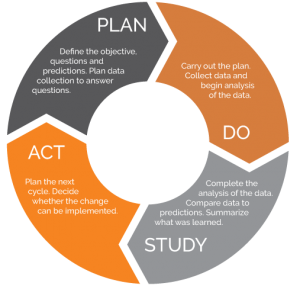During a time when communities and policies are changing, it is important to ensure the programs and services within those communities are constantly evolving to meet the needs of families. The Continuous Quality Improvement (CQI) model is an ongoing process for organizations to be able to determine whether or not a change made led to an improvement in quality. In order to move toward making the necessary improvements, a review of what occurred is conducted through a CQI process like the Plan-Do-Study-Act (PDSA) cycle.
Steps to Complete a PDSA Cycle
At Transform Consulting Group, we utilize this consistent approach when working with organizations to help them find solutions.
Plan:
Before beginning your PDSA cycle, identify the problem or issue you would like to address for quality improvement. The problem identified will guide your purpose for the review. Once you have decided what to focus on, consider the following steps to plan to test your idea for change:
- Define the goals
- Define your research question(s)
- Make predictions
- Determine details for implementation of change or intervention
- Plan of action for data collection
During this phase, we work with the client to thoughtfully plan to implement their new or current program/ service. So often, organizations jump immediately to step 2 – “Do” – without completing this critical first step. During the planning phase, we define what we hope to accomplish especially if we are proposing a change. Then we determine how the proposed change/ intervention will be implemented and work through all of the details. Lastly, we finalize how data will be collected.
Do:
This phase of the PDSA cycle requires you to conduct the test for the change or intervention. It is during this phase that you will complete the following tasks:
- Carry out the intervention
- Collect data
- Begin data analysis
This step in the process is what most organizations know and are doing. Organizations are delivering interventions every day with their services. They might be intentionally or unintentionally modifying their intervention. The “Do” step in this process is not new to organizations. It is wrapping it around the other three steps that make this work transformational!
Study:
The study phase of the cycle occurs after you have completed your intervention. You then analyze the data to study what did or did not occur. Organizations will want to review their predictions and assumptions before conducting the test. You will want to take the following steps during this phase of the cycle:
- Complete data analysis
- Compare data to predictions
- Summarize the information
Organizations often skip over this step in the process or do not spend enough time thoughtfully reviewing the data. For some organizations, their data can be considered “high stakes” and there is a tendency to want to focus on the positive changes/ results that occurred and glance over the changes that did not occur or the benchmarks that were not met. During this phase, it is so important for an organization to be transparent and honest with themselves when reviewing the data.
Act:
Based on the summarized information, this last phase of the cycle allows you to determine what modifications may be needed to ensure that the goals you set will be met. Your organization may decide to modify a program element or change how a service is delivered; you may decide to target a different population or use a new curriculum. Once you have determined whether or not to adapt, adopt, or abandon your intervention, you will be prepared to do the following:
- Plan next cycle
- Decide whether the change can be implemented
During this last step, your organization takes all of the information gathered to make data-informed decisions that will ultimately improve your results. This is the exciting part of the process and one that you don’t want to skip. This step and the overall PDSA process will help your organization continue to improve the quality of services provided and impact in the community.
At Transform Consulting Group, we follow this consistent approach when helping you find solutions to accelerate your impact. If you are looking to improve the quality of a service or program to facilitate positive change, contact us today!
